The List: 8 Best Condenser Microphones
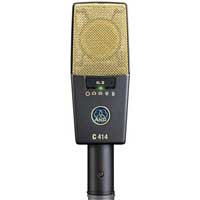
Check Price:
Best Overall
- A ubiquitous legend with modern sound and incredible high-end clarity
- Great on vocals, drum overheads, guitars and any application you throw at it
- 9 polar patterns
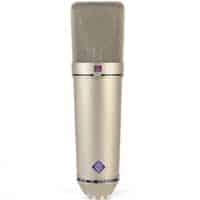
Check Price:
Best High-end Mic
- The gold standard for large-diaphragm studio condensers
- Delivers transparent, true-to-life (with something extra on top) results
- Tried and tested on famous recordings since 1967
- Versatile
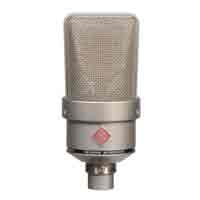
Check Price:
Gem for Vocals
- Same components as the famous U87 at one-third the price
- Fantastic for Vocals
- Pristine high end
- Musically responsive
- low self-noise
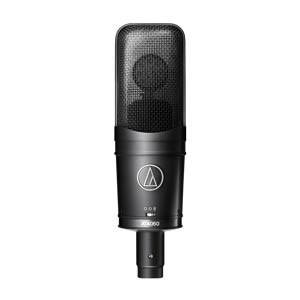
Check Price:
The Dark Horse
- The hidden champion. A go-to for vocals and drum overheads.
- Extended highs, clear mids, full bottom – everything with a silky color
- 3 polar patterns
- Excellent off-axis response
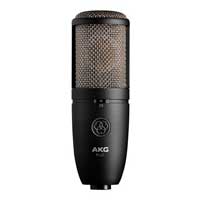
Check Price:
Budget Pick
- A quality budget condenser with a nice neutral response.
- 3 polar patterns
- Lacks the overhyped treble of most budget condensers
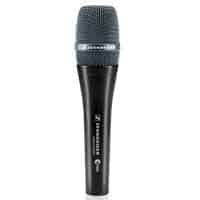
Check Price:
Handheld that Can Do It All
- A great condenser rugged enough for live performance
- Excellent on Studio Vocals or Podcasting
- Switchable polar patterns: Cardioid, Super-cardioid
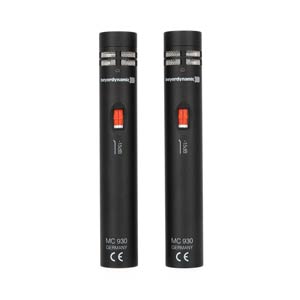
Check Price:
Best Small-Diaphragm Condenser
- A wonderfully balanced sound for a small-diaphragm condenser
- Much cheaper than the usual small-condenser favorites (KM 184)
- Ultra-fine HF detail, great for strings, guitars, piano, sound design, or ASMR
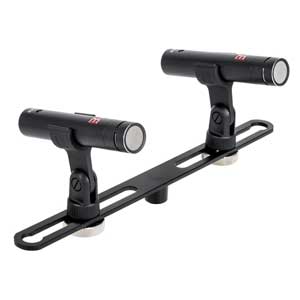
Check Price:
Small Diaphragm Budget Pick
- Great HF detail resolution
- Delivers above its price point
- Quality build
- Excellent carry case and accessories
Intro
Condenser mics are the preferred mic on studio vocals, acoustic guitars, ensembles, strings, drum overheads, and more. Essential in any recording studio, the condenser mic offers more transparency and detail than any other mic.
The landscape of condenser microphones is vast. We’ve tried most of the top condenser mics worth talking about over years of recording to create this buyer’s guide.
How We Chose the Best Condenser Microphones
To avoid overwhelming you with options, we have narrowed the field to a select few. If a popular mic is not on this list, it doesn’t necessarily mean we think it is a bad mic. The market is fiercely competitive with loads of good options out there.
These mics are our favorites picked from a wide range of condenser microphones. We have included two small-diaphragm condensers, and a selection of large-diaphragm condensers, each with a distinct sonic signature.
We have not included any tube condensers on this list. We will cover our favorite tube condensers in another post. (Spoiler: our favorite tube mic is the Mojave MA-200)
Without further ado, our favorite condenser microphones…
See here for knowledge and reviews of microphones, and here for all of our audio gear reviews.
Best Overall
AKG C414 XLII
our rating
5.0
Check Price:
Bottom Line:
A ubiquitous legend with modern sound and incredible high-end clarity. Handles vocals, guitars, and anything you throw at it with aplomb.
Recommended Applications:
- Studio Vocals (all styles and voice types)
- Acoustic guitar
- Guitar Amps
- String Instruments
- Drum overheads and drum room mics
- Piano
- Chamber ensembles
- Choirs
- Orchestras
Build
The AKG C414 XLII is the company’s flagship, multi-pattern large-diaphragm condenser mic built with the famous, gold-sputtered CK12 capsule and FET-Transformerless circuit. The XLII is the latest, slightly brighter-sounding iteration of this mic with roots reaching back to the C12 of the 1950s.
The mic offers five main polar patterns on the mic (Omni, wide cardioid, cardioid, hyper-cardioid, and figure-8) as well as 4 in-between patterns. It also has an onboard attenuation pad with three settings (-6, -12, and -18 dB) and a high-pass filter with three settings (40, 80, and 160 Hz).
With a max SPL of 134 dBA and a self-noise of 6 dBA, the dynamic range is outstanding.
Available as a single mic or as a matched pair, the C414 ships with high-quality accessories: a shockmount, a foam windscreen, a pop filter, and an aluminum flight case.
Sound
The C414 XLii retains the classic modern sound of its predecessors and does a lot of things well in the studio. That is why these mics are found in every major recording studio.
For vocals, it’s high-end clarity has a smooth edge to it. The dynamic range also makes it ideal for recording piano or even orchestras.
Sung Vocals Test, Cardioid: AKG C414 XLII
The frequency response in all polar patterns is relatively flat with a wide presence peak spanning roughly 2-13 kHz.
Acoustic Guitar Test, Cardioid: AKG C414 XLII
Verdict
This is a fantastic mic in every way. And, compared with the flagship models of other companies, the price is very reasonable. If this mic is your choice, you won’t be disappointed.
(*Note, Many think that the AKG C214 is a fixed-cardioid, cheaper version of this mic. That is not true. Although the C214 is an excellent mic in its own right, it has a considerably different sound signature.)
Best High-end Mic
Neumann U87 ai
our rating
5.0
Check Price:
Bottom Line:
The tried-and-tested gold-standard for large-diaphragm condenser mics
Recommended Applications:
- Studio Vocals (all styles and voice types)
- Acoustic guitar
- Guitar Amps
- String Instruments
- Drum overheads and drum room mics
- Piano
- Chamber ensembles
- Choirs
- Orchestras
Build
The U87 has a K67 capsule with two center-terminated, gold-plated mylar diaphragms placed back to back. The double-diaphragm design allows the mic to capture sound from all directions. The U87 Ai has three polar patterns: Cardioid, Figure-8, and Omnidirectional.
The sweetness of the K67 capsule is harmonically colored by the U87’s FET (field effect transistor) and transformer, forming the unique sound of the U87.
Sound
The frequency response of the U87 in all polar patterns is about as neutral as you will find with a tiny lift around 10 kHz.
The brilliance of this mic is its transparency. You’re not dealing with an overhyped, sexy sound. The mic offers instead an elegant, refined, malleable result.
Some recordists might be looking to hear a silky, produced sound from this expensive microphone and be disappointed by the natural-sounding results from the U87. Its beauty lies in how well it delivers authentic detail with a little larger-than-life sparkle.
Sung Vocals Test, Cardioid: Neumann U87 ai
Testing it for different recording applications, its versatility was evident. The polar patterns figure-8 and omni offer breath and distance, while the cardioid pattern feels appropriately intimate.
Unlike some mics where one has to be completely still while recording, the U87 allowed for natural movement. It produced an even response regardless of a head bob or lyric check.
Acoustic Guitar Test, Figure-8: Neumann U87 ai
Verdict
The advantage this mic has over almost any other mic is that it has been tried and tested for over half a century. Technically, the U87 can deliver. That much is indisputable.
It works and sounds great on a wide range of applications from solo vocals to entire orchestras. And, if you want to know how it sounds on a particular application, consult one of the many famous recordings out there.
The only downside to this mic is the high price tag.
I believe the TLM 103 (complete review of the Neumann TLM 103) and Mojave MA-201 FET are tough, more affordable competitors with a similar sound signature to that of the U87. But still, I’d rather have a U87.
See here for our complete review of the Neumann U87.
A Gem for Vocals
Neumann TLM 103
our rating
4.9
Check Price:
Bottom Line:
A chunky wedge-shaped version of the famous U87 microphone at one-third the cost.
Recommended Applications:
- Studio Vocals (all styles and voice types)
- Acoustic guitar
- Guitar Amps
- String Instruments
- Piano
Build
The Neumann TLM 103 is essentially half of a U87 without the transformer. It has the same K67-style capsule in a fixed cardioid pattern and a FET-Transformerless circuit.
Its entire construction was built with the following question in mind: “How can we make a more affordable U87?”
Sound
The TLM 103 has a flat frequency response with a gentle presence boost around 5 – 15 kHz. This frequency response is nearly identical to that of the U87.
Acoustic Guitar Test: Neumann TLM 103
The mic has no problems with plosives or sibilance. And the off-axis response is very consistent, with very little coloration.
The super-clean high-end that the TLM 103 gives to the vocals here below is what ultimately wins me over on this mic. Somehow, the detail is more detailed, but in a flattering way.
This was recorded with the mic at lip level with the acoustic guitar on my lap.
Sung Vocals Test: Neumann TLM 103
Verdict
All in all, the TLM 103 delivers a musical response, a pristine high-end delicately balanced with a full low-end, and low self-noise. Even though it is a U87 wanna-be, it’s an absolute gem in its own right.
(See here for our complete review of the Neumann TLM 103.)
The Dark Horse
Audio-Technica AT4050
our rating
4.8
Check Price:
Bottom Line:
The hidden champion. A versatile, silky condenser mic that has become a go-to for vocals and drum overheads.
Recommended Applications:
- Studio Vocals (all styles and voice types)
- Acoustic guitar
- Guitar Amps
- String Instruments
- Drum overheads and drum room mics
- Piano
- Chamber ensembles
- Choirs
- Orchestras
Build
The Audio-Technica AT4050 is an often overlooked mic, the company’s flagship multi-pattern condenser. Since it arrived on the scene nearly 30 years ago, the mic has become a ubiquitous, go-to mic for vocals and drums.
The AT4050’s innards include a K67-style capsule and a FET-transformerless circuit.
On the body of the mic, you’ll find a polar pattern switch offering three patterns: cardioid, omni, and figure-8. The AT4050 also has an onboard attenuation pad (-10 dB) and a high-pass filter (starting at 80 Hz).
The mic has an extraordinary max SPL of 149 dB (without the attenuation pad), in case you plan to record rocket launches.
The AT4050 ships with a shockmount, a dust cover, and a carry case.
Sound
The frequency response of the AT4050 in cardioid pattern is neutral with a 5 dB peak at 10 kHz, rolling off at 17 kHz. Notably, in the figure-8 pattern, the mic offers a presence peak of about 4 dB from 6-12 kHz, offering a bit of treble shimmer.
In general, this mic’s response has personality. It’s not giving you bland results. Everything sounds silkier than in real life.
It is worth checking out the AT 4033a, a fixed-cardioid version of this mic, if you plan to use only one polar pattern.
Acoustic Guitar Test: Audio-Technica AT4050
The off-axis response of the AT4050 is one of its strong points. Used in Blumlein or Mid-side recording, its consistent response is much appreciated.
The high-frequencies feel extended somehow, the mids clear, the bottom full. It is an excellent choice for female vocals or vocals of any sort.
With a self-noise of 17 dB, the 4050 is a little noisier than other options. However, in most recording applications, this is not enough to be problematic. You can hear for yourself on this intimate vocal below.
Sung Vocals Test: Audio-Technica AT4050
Verdict
AT4050 owners tend to be proud and loyal. It is the under-sung hero of large diaphragm condensers. Its three polar patterns and musical response make it suitable for nearly any recording application.
And comparing the price with other mics in its class, you’re getting serious value.
Budget Pick
AKG P420
our rating
4.6
Check Price:
Bottom Line:
A versatile budget condenser with a satisfying neutral response.
Recommended Applications:
- Studio Vocals (all styles and voice types)
- Acoustic guitar
- Guitar Amps
- String Instruments
- Drum overheads and drum room mics
- Piano
- Chamber ensembles
- Choirs
Build
The build of the AKG P420 imitates a Neumann U87 ai, with a K67-style capsule, a field effect transistor (FET) and a small transformer (rarely found in budget mics) to balance the output. The P420 comes equipped with three switchable polar patterns: cardioid, omni, and figure-8. Also onboard are a high-pass filter and a -20 dB attenuation pad.
The P420 predecessors were the Precision series. All of the P-series AKG mics are manufactured in China, and the C-series are made in Austria.
The mic comes with a high quality steel carry case, pop filter, and shockmount.
Sound
With the P420, AKG have done a great job at making a budget mic without the overly hyped top-end that almost all budget studio condensers have.
Spoken Word Test: AKG P420
The sonic signature of this condenser is neutral, on the slightly warm side. With a frequency range from 20Hz to 20 kHz and a maximum sound pressure of 135dB (155 dB with the attenuation pad), this mic is designed to work the widest range of home studio applications.
Its self-noise is listed at 15 dBA. Although the mic is noisier than many options here, it is hardly noticable unless you are only recording intimate sounds like classical guitar or acapella vocals.
On Vocals, guitar or overheads, the P420 delivers above its price point, offering a quality, workable result.
Acoustic Guitar Test: AKG P420
Verdict
If you’re just getting started recording at home, the P420 offers excellent versatility without the cheap sound. It’s simply a great budget mic.
(For other budget options see our Best Mic under 500 post.)
The Handheld that Can Do It All
Sennheiser e965
our rating
4.7
Check Price:
Bottom Line:
A great condenser rugged enough for live performance and fine enough for the studio.
Recommended Applications:
- Live Vocals
- Studio Vocals (all styles and voice types)
- Acoustic guitar
- Guitar Amps
Build
The Sennheiser e965 is a unique, handheld multi-pattern condenser. Its build offers the low-handling noise of a dynamic mic with all the benefits of a large-diaphragm condenser.
Condenser mics for the stage are not entirely uncommon these days. Usually, they are small diaphragm condensers rigged for stage use. The e965 however, has a full 1-inch diaphragm, which gives it a larger-than-life sound and a fuller low end.
By screwing off the grille, you can switch to a super-cardioid polar pattern for a tighter pick-up pattern. Also hidden under the grille are an attenuation pad (-10 dB) and a high-pass filter to get rid of boominess (recommended).
With a max SPL of 152 dB, this mic can handle the loudness.
Sound
The frequency response in the cardioid pattern is flat with a wide presence lift from 5-12 kHz and slightly wider in the super-cardioid pattern from 3-12 kHz.
Spoken Word Test, Cardioid: Sennheiser e965
The mic simply works out of the box. As a live mic, the E965 gives detail and subtlety that you simply cannot find in a dynamic mic.
But don’t be fooled by the handheld shape! We also liked it as a studio mic, especially on vocals. I would suggest always using the super-cardioid setting in the studio as the mic is not meant to have consistent off-axis response.
Acoustic Guitar Test: Sennheiser e965
Verdict
If you cannot afford both a vocal studio mic and a stage mic, the Sennheiser e965 is a perfect solution.
Best Small-Diaphragm Condenser
Beyerdynamic MC 930
our rating
4.9
Check Price:
Bottom Line:
Our favorite small-diaphragm condenser with a lovely, balanced sound and ultra-fine high-frequency detail. Great for guitars, piano, strings, ensembles, and sound design.
Recommended Applications:
- Live and studio recordings of ensembles, orchestras, classical music, jazz
- Acoustic guitars, violins, banjos, and other strings
- Drums (overheads, snare, high-hat, cymbals)
- Piano
- Flute, Oboe
- Sound-design
Build
The MC 930, a small-diaphragm FET condenser mic, is our favorite small-diaphragm condenser.
Available as a single mic or as a matched pair, the MC 930 does everything a small-diaphragm condenser should do, namely pick up high-frequency detail better than any other mic and deliver honest, natural-sounding results.
The matched pair we reviewed came with a hard-shell foam-lined plastic carry case, foam windshields, and shock mounts.
Sound
The frequency response is flat with a tiny 1 dB peak from 5-12 kHz. You’re getting low-frequency presence with an ultra-clear, high extension. It’s so nice to hear a balanced sound in a small-diaphragm condenser without too much zest in the treble.
Acoustic Guitar Test, Single Mic: Beyerdynamic MC 930
The transient response is lightning quick, making this mic ideal for the quick attack of strings, guitars, or snares and hi-hats.
The MC 930 is ideal as a matched pair for stereo recording, as you can hear below.
Acoustic Guitar Test: X-Y pair, Beyerdynamic MC 930
Verdict
These mics are considerably cheaper than the Neumann KM 184, and the results are just as good, if not better.
Small-Diaphragm Budget Pick
SE Electronics SE8
our rating
4.8
Check Price:
Bottom Line:
A small diaphragm condenser with excellent HF detail that delivers above its price point.
Recommended Applications:
- Live and studio recordings of ensembles, orchestras, classical music, jazz
- Acoustic guitars, violins, banjos, and other strings
- Drums (overheads, snare, high-hat, cymbals)
- Piano
- Flute, Oboe
- Sound-design
Build
The SE8, another pencil-shaped, small-diaphragm condenser mic, is a budget version of the MC 930.
They come with attenuation pads (-10 and -20 dB) and a hi-pass filter. The innards consist of half-inch gold-sputtered diaphragms which are handmade in the Shanghai factory
The frequency response of the SE8 is flat with a tiny presence peak from 5-8 kHz.
The included accessories are excellent: an aluminum carry case with stand clips, a stereo bar, and two foam windscreens. The build quality of all the materials is premium.
Sound
The overall sound of the SE8 is brighter than the MC 930 and not as well balanced at the bottom. But the SE8 still delivers above its price point in its natural detail retrieval and relatively low self-noise (13 dB).
We tested these recording the delicate trigger sounds of ASMR. (You can watch the video here) These were our favorite option as they excel at picking up high frequency detail.
Verdict
The SE Electronics SE8 have quick transient response and deliver excellent detail. And, there’s nothing overly metallic or harsh about the results like most small condensers in the same class.
For those in search of a budget, small-diaphragm condenser or stereo pair, look no further than the SE8.
A Quick Overview of Different Types of Condenser Mics
Here’s a quick overview of what’s involved in choosing a condenser mic. See here for a deeper dive into condenser mics and how they work.
Large or Small
First of all, to choose the right condenser mic, consider the pros and cons of using a large or small-diaphragm condenser.
The size of the diaphragm in a condenser mic determines how well it will respond to different frequencies. Consequently, small-diaphragm condensers are more effective at picking up fine, top-end detail and quick transients (e.g., acoustic stringed instruments, or squishy sounds for ASMR videos). They also have the most consistent pick-up patterns.
Large-diaphragm condensers, with fuller mids and lows, are usually the mic of choice for vocals, drum overheads, and guitar amps. In addition, they typically have lower self-noise than small-diaphragm condensers.
Capsule and Circuit
Secondly, the microphone capsule and the circuit will determine the overall sound signature of the condenser microphone. The capsule is the primary influence on the sound and the circuit typically adds harmonic coloration.
There are four common capsules used in most condenser mics: the M7, K47, K67, and CK12 capsules. And there are three typical circuit configurations: Tube-Transformer, FET-Transformer, and FET-Transformerless.
This means that a mic with a K67-style capsule and a Tube-Transformer circuit will have quite a different sound to a mic with a CK12 capsule and a FET-Transformerless circuit.
Questions or Comments?
Follow the discussion here on Facebook.